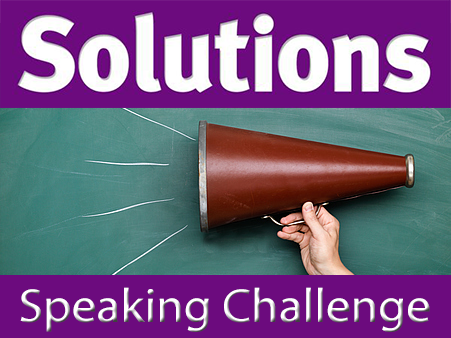
Mixed-ability groups present a particular challenge for teachers when trying to promote speaking skills. For every student who gets actively involved in class, there is another who does as little as possible. For every student who speaks, there is another who stays quiet. For every hand that goes up, there is another which stays down.
Naturally, our aim is to get all the students involved. In reality, however, when a lesson is not going as well as hoped we tend to modify our goals. Unable to involve everyone, we settle for what we can get. Rather than noticing that only the stronger students are getting involved, we are simply grateful that at least somebody is saying something. The fact that weaker students are getting a free ride in the lesson can pass us by.
So how can we get the weaker students to join in speaking tasks?
The following questions are crucial to a full understanding of the challenge:
What do we mean by weaker students?
In most cases we mean students whose level of spoken English is below that of the other members of the group. What we need to be careful of, however, is making the assumption that level of spoken language proficiency matches strengths and weaknesses in other areas. A student who is weaker at speaking may have strengths in other areas which can be capitalised on when it comes to speaking.
What do we mean by a mixed-ability group?
The groups we teach are ‘mixed ability’ not only in the sense that they are heterogeneous but also in the sense that the students themselves are simultaneously proficient at some things and weak at others.
Every student we teach has strengths, talents and skills. The first thing we need to do if we are to encourage weaker students to speak in class is to boost their confidence. And the best way we can do that is to find their strengths and focus on them in a real, relevant and constructive way.
Can’t speak or won’t speak?
When we open our mouths to speak we become vulnerable. In many situations, when weaker students decide not to join in, they are making an entirely understandable decision. Why risk making a mistake or looking foolish in front of the rest of the class?
This is where teachers come in. We need to create a classroom dynamic which nurtures confidence. We need to be attentive, appreciative, sensitive, supportive and – where necessary – protective. The only way students will find the confidence to speak is if they feel they can put their trust in the teacher and the learning environment s/he creates in the classroom. Before we rush to experiment methodologically, it is vital to remember that the ideas and techniques we implement will only be effective if the essential foundations of trust and confidence are already in place.
That brings us to the practicalities of the lesson: how we set up, manage and review speaking tasks. We have already established that it is hard to get weaker students to join in. Is there anything practical we can provide them with that will make a positive difference?
– Time
This has both a micro- and a macro-dimension. In the context of a single lesson, students need to be given enough time to formulate a response or utterance, as well as a chance to plan it and rehearse it. At the start of a course, meanwhile, we should not expect students to start speaking a great deal in the very first lesson – they need to be given enough time to acclimatise and feel secure in the classroom.
– Options
Speaking tasks tend to work best when they have options built in – options regarding roles, tasks and outcomes. For example, providing different speakers with a number of different communicative roles to choose from is an effective way of ensuring that all students feel confident and in control.
– Variety within tasks and modes of interaction
Differentiated activities can enable weaker students to complete speaking tasks at a level appropriate to their abilities. This does not necessarily mean segregating the weaker students from the stronger ones: in fact, as we shall see, some of the best differentiated speaking activities are based on weaker and stronger students working together to complete a joint task.
– Resources
Less confident speakers are more likely to lose their nerve before a speaking activity begins. We need to provide them with three important resources: information, language and encouragement. They need to have a clear idea of what to do and how to do it. They need to know how much time is available to prepare and for how long they have to speak. They need plenty of language resources, such as useful phrases and expressions. And as they prepare, they need to have someone they can ask for help, someone to encourage them.
Yes, it’s hard getting the weaker students to join in. There are days when it cannot be done. With the right strategies in place, however, we can expect to see some positive changes over time.
Register for Edmund Dudley’s webinar ‘Solutions Speaking Challenge #3: Promoting speaking in the mixed ability classroom’ on either Wednesday 25th July or Friday 27th July to explore this challenge further.